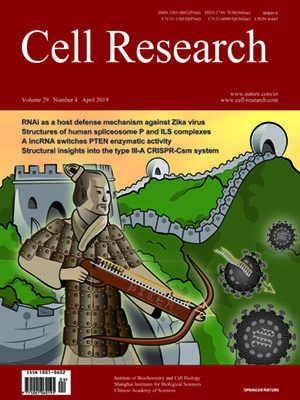
Volume 29, No 4, Apr 2019
ISSN: 1001-0602
EISSN: 1748-7838 2018
impact factor 17.848*
(Clarivate Analytics, 2019)
Volume 29 Issue 4, April 2019: 334-336 | Open Access
LETTERS TO THE EDITOR
CRISPR/Cas9-mediated PINK1 deletion leads to neurodegeneration in rhesus monkeys
Weili Yang 1, Yunbo Liu 2, Zhuchi Tu 1, Chong Xiao 2, Sen Yan 1,Xishan Ma 2, Xiangyu Guo 1, Xiusheng Chen 1, Peng Yin 3, Zhengyi Yang 4, Su Yang 3, Tianzi Jiang 4, Shihua Li sup>3, Chuan Qin 2 and Xiao-Jiang Li 1,3
1 Guangdong-Hongkong-Macau Institute of CNS Regeneration, Ministry of Education CNS Regeneration Collaborative Joint Laboratory, Jinan University, 510632 Guangzhou, Guangdong, China; 2Institute of Laboratory Animal Science, Chinese Academy of Medical Sciences and Peking Union Medical College, 100021 Beijing, China; 3Department of Human Genetics, Emory University School of Medicine, Atlanta, GA 30322, USA and 4Brainnetome Center, Institute of Automation, The Chinese Academy of Sciences, 100190 Beijing, China
These authors contributed equally: Weili Yang, Yunbo Liu
Correspondence: Shihua Li (sli@emory.edu) or Chuan Qin (qinchuan@pumc.edu.cn) or Xiao-Jiang Li (xli2@emory.edu)
Dear Editor,
PINK1 mutations cause autosomal recessive and early-onset Parkinson’s disease (PD) with selective neurodegeneration. Unfortunately, current PINK1 knockout (KO) mouse1,2 and pig models3,4 are unable to recapitulate the selective and overt neurodegeneration seen in PD patients. Furthermore, endogenous Pink1 in the mouse brain is expressed at very low levels and can only be detected via immunoprecipitation,5 meaning that PINK1’s function in the mammalian brain needs to be assessed using larger animals that are closer to humans. We previously used CRISPR/Cas9 to target the monkey gene in one-cell stage embryos.6 Using the same approach, we designed two gRNAs to target exon 2 (T1) and exon 4 (T2), which encode a kinase domain in the PINK1 gene of rhesus monkeys (Fig. 1a). CRISPR/Cas9 and PINK1 gRNAs were injected into one-cell stage rhesus monkey embryos. A T7E1 assay and sequencing of PCR products from the injected embryos showed high efficiency (61.5%) in targeting PINK1 (Fig. 1b and Supplementary information, Fig. S1). Transfer of 87 embryos to 28 surrogate rhesus monkeys resulted in 11 pregnancies (39.2%) (Fig. 1b). Eleven fetuses developed to term and were born naturally. Of these live monkeys, eight carried PINK1 mutations (M), and three were wild type (WT). However, three mutant monkeys (M1, M3 and M4) were newborn triplets that struggled to survive and died 3-4 days after birth. One WT newborn monkey also died after a difficult labor. Another mutant monkey (M2) died 7 days after birth without noticeable warning signs or symptoms. The other three mutant monkeys (M6, M7 and M8) have lived for three years; M5, however, reduced its food intake and showed weakness at the age of 1.5 years, and died 30 days after anesthesia for MRI examination.
https://doi.org/10.1038/s41422-019-0142-y
FULL TEXT | PDF
Browse 1417


